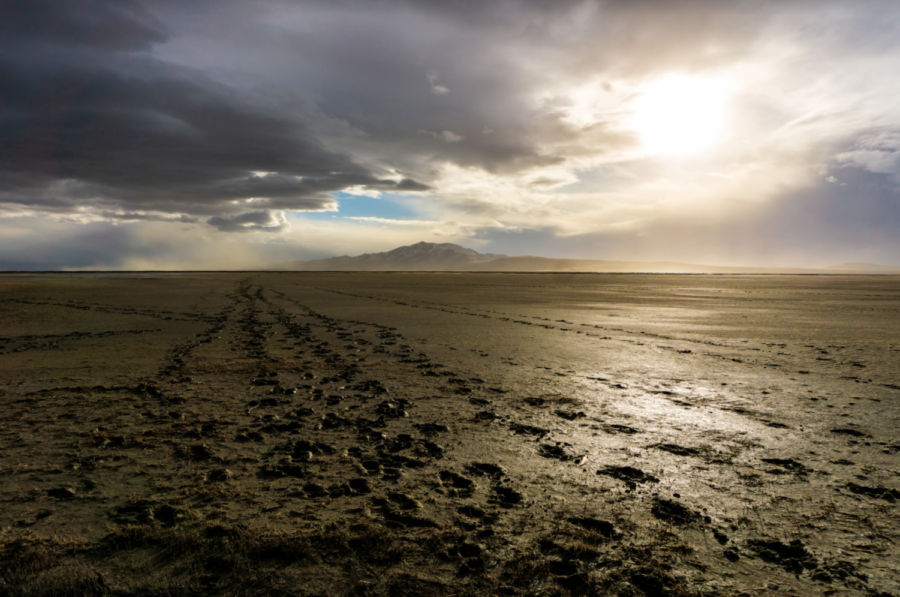Why We Need to Help Save The Great Salt Lake
I remember the first time the Great Salt Lake took my breath away. I was at the north shore, near Rozel Point. A cool autumn mist hung low over the lake, obscuring any indication of place, scale, or time. The water was rose-colored, like blushing cheeks. As I stood at the shore’s edge, the glassy lake reflected the misty atmosphere above it perfectly, blurring boundaries between earth and sky. The experience was both ethereal and intensely real.
That encounter happened nearly a decade ago. Now, if I were to walk to that same spot, the water would be an indeterminate distance away. In contrast, I recently went kayaking on the Great Salt Lake near Antelope Island, underestimating the time it would take to carry our heavy gear out to the receding shore. Once we finally arrived at the water, it was still several feet until it was deep enough to paddle. These experiences, so different in nature, not only personally attest that the Great Salt Lake is drying up, but that it’s happening rapidly enough to disappear within our lifetime.
Not everyone’s first experience with the Great Salt Lake will be so fond. Its salty shores attract swarms of bugs, ensuring a celebratory feast for birds but an evening of bite-relief cream for us humans. Farmington Bay, which serves as an entry to the lake for many, doubles as a sewage treatment facility and produces algal blooms that have a smell of their own, lending the lake a “stinky” reputation that is only true part of the time.
Fiona Summers, an Environmental Humanities master’s student at the University of Utah, recalls that when she moved to Utah, she was puzzled why a peninsula in the lake would be called “Antelope Island.” She remembers, “Every map I looked at showed Antelope Island as an actual island connected to the mainland by a road, but today there is a considerable amount of land connecting the two areas.” After asking some locals about it, she then “learned of the dramatic loss of water the Great Salt Lake has experienced in the last five decades. I became greatly saddened by the fact that this very ecologically and culturally important body of water was disappearing right before us.” 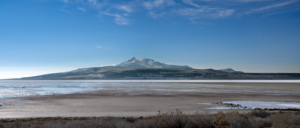
This important body of water is a place of extremes. It’s at once stark yet full of life, a wetland oasis located next to a metropolitan area, which is located next to a mountain range. It’s a pool of water in the middle of a desert that we can neither drink from nor fish in because it has a salinity that’s three to five times saltier than the ocean. Snowpack trickles down the Wasatch Mountains and joins with the Bear River, Weber River, and Jordan River like veins to a heart, ending in a terminal lake that never meets the ocean. At about 1,700 square miles, it’s the largest saline lake in the western hemisphere.
While you won’t find fish in the Great Salt Lake, you’ll find an abundance of halophilic (salt-loving) bacteria and algae, brine shrimp, and brine flies. This unique sea life provides for larger fauna, including 10 million birds a year; it’s a crucial migratory stop of the Pacific flyway and the top breeding spot for pelicans in the entire country. In terms of ecological significance, it’s hard to overstate the lake’s role on a global scale. Additionally, the lake is an invaluable economic boon for the state of Utah, supporting an international supply of brine shrimp eggs to the world’s shellfish industry, as well as industries of salt and magnesium. The fresh powder that gives Utah the trademark “Greatest Snow on Earth” wouldn’t be as great without the “lake effect,” a distinct influence on our local weather systems. And, in engaging with the landscape that is the Great Salt Lake area, there’s something for everyone. There are opportunities to bike, hike, and backpack on the lake’s islands; paddleboard, row, and canoe in its waters; or see Robert Smithson’s world-famous “Spiral Jetty” on its north shore.
Hannah Taub, another U of U master’s student, fostered a deep appreciation for this landscape as she explored it over several months as an Interpretive Intern for Antelope Island State Park. Her research in collaboration with the Northwestern Band of Shoshone highlights the importance of the lake to Indigenous peoples. She says, “Antelope Island and other locations around the lake’s ancient shoreline contain artifacts hinting at the rich human history of this region, which was sustained in part by the lake.” This documented Indigenous presence near the lake goes “back to the Archaic period of human history, and it still holds significance for Indigenous people in the area today.”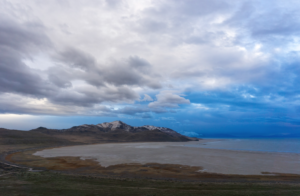
The Great Salt Lake’s shoreline has always had a dynamic ebb to it due to its unique plate-like shape—but now, the lake reaches a historic low in a sustained downward trajectory that alarms scientists and lake-lovers alike. The lake has lost over half its surface area and several feet of depth since its historic high in the 1980s. Because the lake is a terminus, water diversion prior to the lake ensures that humans get a share of the watershed; whatever water arrives at the lake is legally considered “waste.” But with increasing thirst in the valley due to development, industrial activity and growing populations, we’re beginning to see the consequences of our interference. In short, water is being withheld from a lake that needs it. Crucially, this practice is exacerbated by the climate crisis and historic droughts in the West, which are both projected to continue for the foreseeable future, even in best-case scenarios. If the lake continues on this course — and if we continue to divert large amounts of water from it—the results could be catastrophic.
As a grim start, internationally significant avian feeding and nesting spaces could completely disappear. As the lake’s shrinking surface area opens land bridges that enhance predator access, it also threatens microbialites (reef-like microbial communities), which would cascade effects onto brine flies and brine shrimp, and thus bird populations. Secondly, multi-billion-dollar economies and employment that rely on the lake will similarly dry up, as could our world-renowned ski slopes without lake-effect snow.
Human health is another concern. The same streams of water that deposit salt in the lake also carry high concentrations of heavy metals — notably arsenic, which causes severe health conditions. Summers warns, “As the lake continues to dry up, the evaporation process leaves behind the minerals on the dry lakebed, which is easily disturbed by wind, carrying toxic heavy metals throughout the air of the Wasatch Front. Ingesting this dust pollution is dangerous because once you breathe it in, it permeates the lung tissues and cannot be expelled from the body.” The wind isn’t known for staying in one place, and with more erosion over time, the dry lakebed has the potential to become a source of hazardous dust pollution for the entire Intermountain West.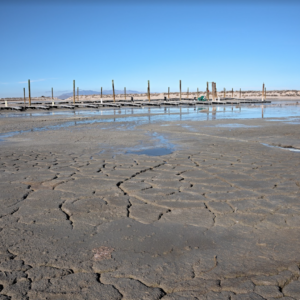
Finally, as Taub notes, “for those of us that live in Salt Lake City, we might have to brainstorm a name change if we eventually no longer live by a salt lake.”
Luckily, there’s a lot we can do to help save this precious lake and prevent what would amount to an environmental, economic and, cultural crisis. As many Utahns feel human choices are responsible for the current condition of the Great Salt Lake, accompanying that responsibility is the obligation to find a solution. Summers mentions, “I am a transplant and a part of the need for an increase of water resources, so I want to do my part to ensure the environment can thrive despite human influences.”
It starts by changing the narrative. In 2019, the Utah legislature passed House Concurrent Resolution 10, recognizing “the critical importance of ensuring adequate water flows to Great Salt Lake and its wetlands, to maintain a healthy and sustainable lake system.” While it’s a start, many believe we need more concrete actions. Taub remarks, “we cannot let our state government get away with giving lip service alone to this issue which requires all of our immediate attention.”
Organizations such as the Great Salt Lake Institute and Friends of the Great Salt Lake have long extolled the virtues of the lake and the need to preserve it through stewardship. More recently, in September of 2021, a collective movement of “organizers, artists, business owners, and concerned citizens” created the “Save Our Great Salt Lake” movement to not only spread awareness but engage grassroots action to influence legislation that will help protect the lake. On their website, the movement specifies goals to “reduce water diversion at the lake, oppose the Bear River Development Project, offer a lower water rate to farmers growing food for Utahns, and enforce water metering and water usage reports from developers.” Summers, who is active in these movements, encourages people to check out each organization to see which aligns most with their passions. However, she says, “the most important action you can take as a community member is voting for policy that supports the protection of the Great Salt Lake.” In the 2022 General Session, this includes supporting House Bill 157 (Sovereign Lands Revenue Amendments), which allocates funds to the Great Salt Lake.
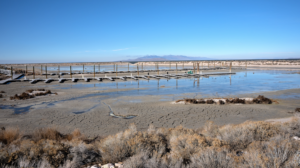 Making changes to help the lake will require deep examinations of current water use habits — both personal and societal — that we take for granted in our exceptionally arid region. It will necessitate changes in both policy and practice that have been embedded into our state for years. It might ruffle some feathers of our non-avian community members as we re-evaluate use by agricultural and industrial organizations and the overall monetary rates of water use.
Making changes to help the lake will require deep examinations of current water use habits — both personal and societal — that we take for granted in our exceptionally arid region. It will necessitate changes in both policy and practice that have been embedded into our state for years. It might ruffle some feathers of our non-avian community members as we re-evaluate use by agricultural and industrial organizations and the overall monetary rates of water use.
Additionally, Taub emphasizes that “we must recognize Indigenous leadership on these issues and seek to highlight Indigenous sovereignty in our discussions of Antelope Island and the Great Salt Lake.” Summers echoes Taub’s thoughts, saying, “My colleagues and I have noticed a lack of Indigenous perspective when discussing this issue at many of the local community events. To describe an issue that is on the ancestral lands of the Ute, Goshute, Paiute, and Shoshone people yet to not consider their input is an injustice. I think the best way to mitigate this ecological crisis will be to collaboratively work with all community members to ensure, rather than assume, everyone’s needs are met.”
Friends of the Great Salt Lake (www.fogsl.org) and Save Our Great Salt Lake (www.saveourgreatsaltlake.org) have resources on their websites and Instagram accounts on how you can get involved to help save this beloved lake.



